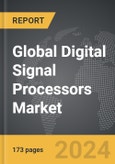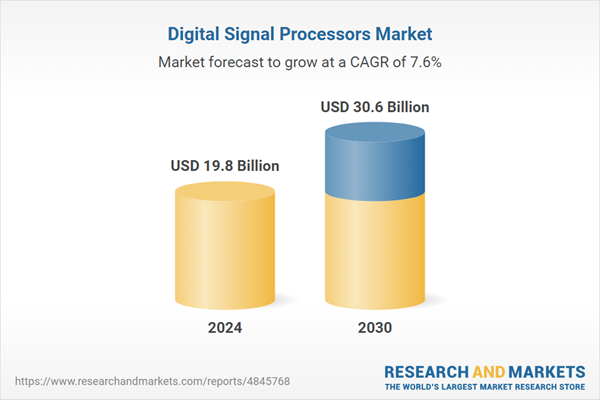The global market for Digital Signal Processors was valued at US$19.8 Billion in 2024 and is projected to reach US$30.6 Billion by 2030, growing at a CAGR of 7.6% from 2024 to 2030. This comprehensive report provides an in-depth analysis of market trends, drivers, and forecasts, helping you make informed business decisions. The report includes the most recent global tariff developments and how they impact the Digital Signal Processors market.
Segments: Type (DSP Multiprocessors on a Die, 32-bit Floating Point, 16-bit Fixed Point); End-Use (Consumer Electronics, Automotive, Healthcare, Manufacturing, Aerospace & Defense, Other End-Uses).
Geographic Regions/Countries: World; United States; Canada; Japan; China; Europe (France; Germany; Italy; United Kingdom; Spain; Russia; and Rest of Europe); Asia-Pacific (Australia; India; South Korea; and Rest of Asia-Pacific); Latin America (Argentina; Brazil; Mexico; and Rest of Latin America); Middle East (Iran; Israel; Saudi Arabia; United Arab Emirates; and Rest of Middle East); and Africa.
The analysts continuously track trade developments worldwide, drawing insights from leading global economists and over 200 industry and policy institutions, including think tanks, trade organizations, and national economic advisory bodies. This intelligence is integrated into forecasting models to provide timely, data-driven analysis of emerging risks and opportunities.
Global Digital Signal Processors Market - Key Trends and Drivers Summarized
What Are Digital Signal Processors and How Do They Work?
Digital Signal Processors (DSPs) are specialized microprocessors designed to perform mathematical calculations on digital signals with high speed and efficiency. Unlike general-purpose processors, DSPs are optimized for handling complex calculations that involve transforming and manipulating signals in real time. This makes them indispensable in applications where precise and rapid signal processing is crucial. DSPs work by converting analog signals, such as sound or light, into digital form through an analog-to-digital converter (ADC). Once in digital form, the DSP processes the data using algorithms to enhance, filter, or compress the signals, and then often converts the processed digital signals back into analog form using a digital-to-analog converter (DAC). This ability to perform real-time signal processing is essential in various fields, from telecommunications and audio processing to medical imaging and industrial automation, making DSPs a cornerstone of modern electronic systems.How Are DSPs Revolutionizing Various Industries?
The integration of DSPs across different industries has revolutionized numerous applications by enhancing performance and enabling new functionalities. In telecommunications, DSPs are fundamental in managing data compression, error detection, and correction, significantly improving the quality and efficiency of communication networks. In audio processing, DSPs enable features such as noise reduction, echo cancellation, and equalization in devices ranging from smartphones to hearing aids. The medical industry benefits from DSP technology in imaging systems like MRI and ultrasound, where high-speed data processing leads to clearer images and more accurate diagnostics. In the automotive sector, DSPs are integral to advanced driver-assistance systems (ADAS) and infotainment systems, enhancing both safety and user experience. Additionally, DSPs play a critical role in industrial automation by improving the precision and control of processes, thereby increasing productivity and reducing operational costs. The versatility and high performance of DSPs continue to drive innovation across a wide array of applications, underscoring their importance in the advancement of technology.What Are the Emerging Trends and Innovations in DSP Technology?
The field of digital signal processing is continuously evolving, with new trends and innovations enhancing the capabilities and applications of DSPs. One significant trend is the integration of machine learning algorithms with DSP technology, enabling more intelligent and adaptive signal processing solutions. This convergence is particularly impactful in areas such as speech and image recognition, where DSPs can process large datasets in real time to improve accuracy and efficiency. Another notable innovation is the development of ultra-low-power DSPs, which are crucial for battery-powered devices like wearable technology and IoT sensors, where energy efficiency is paramount. Additionally, advancements in semiconductor technology have led to the creation of more powerful and compact DSPs, facilitating their integration into smaller and more complex devices. The rise of 5G technology is also propelling the demand for advanced DSPs, as these processors are essential for managing the increased data rates and reduced latency required by next-generation communication networks. As these trends continue to unfold, DSPs are poised to become even more integral to the development of future technologies.What Drives the Growth in the Digital Signal Processors Market?
The growth in the digital signal processors market is driven by several factors, encompassing technological advancements, expanding applications, and shifting consumer demands. The rapid adoption of 5G networks is a major driver, necessitating sophisticated DSPs to handle the high-speed data processing and signal integrity required for seamless connectivity. The proliferation of smart devices and IoT applications is also fueling market growth, as these technologies rely heavily on efficient signal processing to function effectively. In the automotive industry, the increasing complexity of ADAS and autonomous driving systems demands advanced DSPs to process vast amounts of data from sensors and cameras in real time. Additionally, the rise in demand for high-quality audio and video experiences in consumer electronics is boosting the need for powerful DSPs to manage tasks such as noise cancellation, audio enhancement, and video processing. The integration of AI and machine learning with DSP technology is creating new opportunities for innovation and expanding the scope of applications. These factors, combined with continuous advancements in semiconductor technology, are propelling the digital signal processors market forward, making DSPs a critical component in the evolution of modern technology.Report Scope
The report analyzes the Digital Signal Processors market, presented in terms of units. The analysis covers the key segments and geographic regions outlined below.Segments: Type (DSP Multiprocessors on a Die, 32-bit Floating Point, 16-bit Fixed Point); End-Use (Consumer Electronics, Automotive, Healthcare, Manufacturing, Aerospace & Defense, Other End-Uses).
Geographic Regions/Countries: World; United States; Canada; Japan; China; Europe (France; Germany; Italy; United Kingdom; Spain; Russia; and Rest of Europe); Asia-Pacific (Australia; India; South Korea; and Rest of Asia-Pacific); Latin America (Argentina; Brazil; Mexico; and Rest of Latin America); Middle East (Iran; Israel; Saudi Arabia; United Arab Emirates; and Rest of Middle East); and Africa.
Key Insights:
- Market Growth: Understand the significant growth trajectory of the DSP Multiprocessors on a die segment, which is expected to reach US$13.7 Billion by 2030 with a CAGR of a 8.6%. The 32-bit Floating Point segment is also set to grow at 7.2% CAGR over the analysis period.
- Regional Analysis: Gain insights into the U.S. market, valued at $5.1 Billion in 2024, and China, forecasted to grow at an impressive 11.5% CAGR to reach $7.7 Billion by 2030. Discover growth trends in other key regions, including Japan, Canada, Germany, and the Asia-Pacific.
Why You Should Buy This Report:
- Detailed Market Analysis: Access a thorough analysis of the Global Digital Signal Processors Market, covering all major geographic regions and market segments.
- Competitive Insights: Get an overview of the competitive landscape, including the market presence of major players across different geographies.
- Future Trends and Drivers: Understand the key trends and drivers shaping the future of the Global Digital Signal Processors Market.
- Actionable Insights: Benefit from actionable insights that can help you identify new revenue opportunities and make strategic business decisions.
Key Questions Answered:
- How is the Global Digital Signal Processors Market expected to evolve by 2030?
- What are the main drivers and restraints affecting the market?
- Which market segments will grow the most over the forecast period?
- How will market shares for different regions and segments change by 2030?
- Who are the leading players in the market, and what are their prospects?
Report Features:
- Comprehensive Market Data: Independent analysis of annual sales and market forecasts in US$ Million from 2024 to 2030.
- In-Depth Regional Analysis: Detailed insights into key markets, including the U.S., China, Japan, Canada, Europe, Asia-Pacific, Latin America, Middle East, and Africa.
- Company Profiles: Coverage of players such as Fujitsu Ltd., Infineon Technologies AG, Intel Corporation, Intel Corporation, NXP Semiconductors NV and more.
- Complimentary Updates: Receive free report updates for one year to keep you informed of the latest market developments.
Some of the 47 companies featured in this Digital Signal Processors market report include:
- Fujitsu Ltd.
- Infineon Technologies AG
- Intel Corporation
- Intel Corporation
- NXP Semiconductors NV
- Renesas Electronics Corporation
- Samsung Electronics America, Inc.
- Texas Instruments, Inc.
- Xilinx, Inc.
Tariff Impact Analysis: Key Insights for 2025
Global tariff negotiations across 180+ countries are reshaping supply chains, costs, and competitiveness. This report reflects the latest developments as of April 2025 and incorporates forward-looking insights into the market outlook.The analysts continuously track trade developments worldwide, drawing insights from leading global economists and over 200 industry and policy institutions, including think tanks, trade organizations, and national economic advisory bodies. This intelligence is integrated into forecasting models to provide timely, data-driven analysis of emerging risks and opportunities.
What’s Included in This Edition:
- Tariff-adjusted market forecasts by region and segment
- Analysis of cost and supply chain implications by sourcing and trade exposure
- Strategic insights into geographic shifts
Buyers receive a free July 2025 update with:
- Finalized tariff impacts and new trade agreement effects
- Updated projections reflecting global sourcing and cost shifts
- Expanded country-specific coverage across the industry
Table of Contents
I. METHODOLOGYII. EXECUTIVE SUMMARY2. FOCUS ON SELECT PLAYERSIII. MARKET ANALYSISCANADAITALYSPAINRUSSIAREST OF EUROPESOUTH KOREAREST OF ASIA-PACIFICARGENTINABRAZILMEXICOREST OF LATIN AMERICAIRANISRAELSAUDI ARABIAUNITED ARAB EMIRATESREST OF MIDDLE EASTIV. COMPETITION
1. MARKET OVERVIEW
3. MARKET TRENDS & DRIVERS
4. GLOBAL MARKET PERSPECTIVE
UNITED STATES
JAPAN
CHINA
EUROPE
FRANCE
GERMANY
UNITED KINGDOM
ASIA-PACIFIC
AUSTRALIA
INDIA
LATIN AMERICA
MIDDLE EAST
AFRICA
Companies Mentioned (Partial List)
A selection of companies mentioned in this report includes, but is not limited to:
- Fujitsu Ltd.
- Infineon Technologies AG
- Intel Corporation
- Intel Corporation
- NXP Semiconductors NV
- Renesas Electronics Corporation
- Samsung Electronics America, Inc.
- Texas Instruments, Inc.
- Xilinx, Inc.
Table Information
| Report Attribute | Details |
|---|---|
| No. of Pages | 173 |
| Published | April 2025 |
| Forecast Period | 2024 - 2030 |
| Estimated Market Value ( USD | $ 19.8 Billion |
| Forecasted Market Value ( USD | $ 30.6 Billion |
| Compound Annual Growth Rate | 7.6% |
| Regions Covered | Global |









